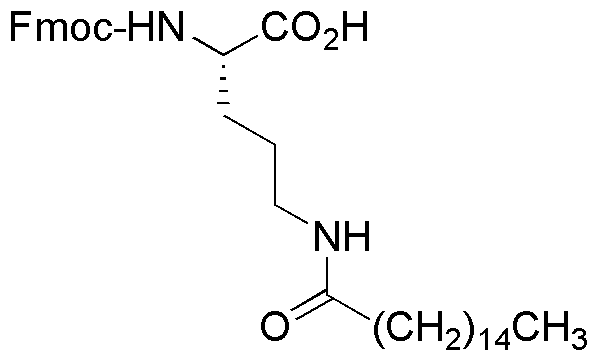Na-Fmoc-Nd-palmitoyl-L-ornithine is widely utilized in research focused on:
- Peptide Synthesis: This compound serves as a key building block in the synthesis of peptides, particularly in creating modified peptides that can enhance stability and bioactivity.
- Drug Delivery Systems: Its unique structure allows for the development of liposomal formulations, improving the delivery of therapeutic agents to target cells, which is crucial in cancer treatment.
- Bioconjugation: The compound can be used to attach bioactive molecules to surfaces or other biomolecules, facilitating the creation of targeted therapies and diagnostic tools.
- Cosmetic Applications: Due to its biocompatibility, it is explored in skincare formulations aimed at improving skin penetration of active ingredients, enhancing their efficacy.
- Research in Membrane Biology: It is utilized in studies involving membrane interactions, helping researchers understand how peptides interact with lipid bilayers, which is essential for drug design.
General Information
Properties
Safety and Regulations
Applications
Na-Fmoc-Nd-palmitoyl-L-ornithine is widely utilized in research focused on:
- Peptide Synthesis: This compound serves as a key building block in the synthesis of peptides, particularly in creating modified peptides that can enhance stability and bioactivity.
- Drug Delivery Systems: Its unique structure allows for the development of liposomal formulations, improving the delivery of therapeutic agents to target cells, which is crucial in cancer treatment.
- Bioconjugation: The compound can be used to attach bioactive molecules to surfaces or other biomolecules, facilitating the creation of targeted therapies and diagnostic tools.
- Cosmetic Applications: Due to its biocompatibility, it is explored in skincare formulations aimed at improving skin penetration of active ingredients, enhancing their efficacy.
- Research in Membrane Biology: It is utilized in studies involving membrane interactions, helping researchers understand how peptides interact with lipid bilayers, which is essential for drug design.
Documents
Safety Data Sheets (SDS)
The SDS provides comprehensive safety information on handling, storage, and disposal of the product.
Product Specification (PS)
The PS provides a comprehensive breakdown of the product’s properties, including chemical composition, physical state, purity, and storage requirements. It also details acceptable quality ranges and the product's intended applications.
Certificates of Analysis (COA)
Search for Certificates of Analysis (COA) by entering the products Lot Number. Lot and Batch Numbers can be found on a product’s label following the words ‘Lot’ or ‘Batch’.
Numéro de catalogue
Numéro de lot/série
Certificates Of Origin (COO)
This COO confirms the country where the product was manufactured, and also details the materials and components used in it and whether it is derived from natural, synthetic, or other specific sources. This certificate may be required for customs, trade, and regulatory compliance.
Numéro de catalogue
Numéro de lot/série
Safety Data Sheets (SDS)
The SDS provides comprehensive safety information on handling, storage, and disposal of the product.
DownloadProduct Specification (PS)
The PS provides a comprehensive breakdown of the product’s properties, including chemical composition, physical state, purity, and storage requirements. It also details acceptable quality ranges and the product's intended applications.
DownloadCertificates of Analysis (COA)
Search for Certificates of Analysis (COA) by entering the products Lot Number. Lot and Batch Numbers can be found on a product’s label following the words ‘Lot’ or ‘Batch’.
Numéro de catalogue
Numéro de lot/série
Certificates Of Origin (COO)
This COO confirms the country where the product was manufactured, and also details the materials and components used in it and whether it is derived from natural, synthetic, or other specific sources. This certificate may be required for customs, trade, and regulatory compliance.


